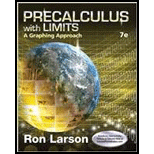
To find: Equation of Hyperbola.
Answer to Problem 6CT
y29−x24=1
Explanation of Solution
Given information:
Vertices = (0,3)and(0,−3)
y=±32x
y=±32x are asymptotes
Slope of Asymptote = ±32
The line y=32x passes through origin.
The line y=−32x also passes through Origin
Therefore, the intersection point of these two lines is Origin that is (0,0) .
The intersection of Asymptotes gives center of the Hyperbola.
Center or Hyperbola = (0,0) = (h,k)
The distance between Center and Vertices is Length of Semi Transverse axis
Length of Semi Transverse axis = √(0−0)2+(0−3)2
⇒a=√(−3)2⇒a=3
The Center origin and the vertices (0,±3) lies on Y-axis. Therefore, the transverse axis of Hyperbola is Vertical.
For a Hyperbola with Vertical Transverse axis,
The slope of two asymptotes are ab and −ab
Therefore
ab=32⇒b=2a3⇒b=2×33⇒b=2
The standard form of the Hyperbola with center (h,k) and with Vertical transverse axis and with length of semi-major axis a and length of semi-minor axis b is
(y−k)2a2−(x−h)2b2=1
Therefore, the required equation of Hyperbola is,
⇒(y−0)232−(x−0)222=1
⇒y29−x24=1
Chapter 9 Solutions
Precalculus with Limits: A Graphing Approach
- 1- √ √ √³ e³/√xdy dx 1 cy² 2- √ √² 3 y³ exy dx dy So 3- √ √sinx y dy dx 4- Jo √² Sy² dx dyarrow_forwardA building that is 205 feet tall casts a shadow of various lengths æ as the day goes by. An angle of elevation is formed by lines from the top and bottom of the building to the tip of the shadow, as de seen in the following figure. Find the rate of change of the angle of elevation when x 278 feet. dx Round to 3 decimal places. Γ X radians per footarrow_forwardUse the information in the following table to find h' (a) at the given value for a. x|f(x) g(x) f'(x) g(x) 0 0 0 4 3 1 4 4 3 0 2 7 1 2 7 3 3 1 2 9 4 0 4 5 7 h(x) = f(g(x)); a = 0 h' (0) =arrow_forward
- Use the information in the following table to find h' (a) at the given value for a. x f(x) g(x) f'(x) g'(x) 0 0 3 2 1 1 0 0 2 0 2 43 22 4 3 3 2 3 1 1 4 1 2 0 4 2 h(x) = (1/(2) ²; 9(x) h' (3)= = ; a=3arrow_forwardThe position of a moving hockey puck after t seconds is s(t) = tan a. Find the velocity of the hockey puck at any time t. v(t) ===== b. Find the acceleration of the puck at any time t. -1 a (t) = (t) where s is in meters. c. Evaluate v(t) and a (t) for t = 1, 4, and 5 seconds. Round to 4 decimal places, if necessary. v (1) v (4) v (5) a (1) = = = = a (4) = a (5) = d. What conclusion can be drawn from the results in the previous part? ○ The hockey puck is decelerating/slowing down at 1, 4, and 5 seconds ○ The hockey puck has a constant velocity/speed at 1, 4, and 5 seconds ○ The hockey puck is accelerating/speeding up at 1, 4, and 5 secondsarrow_forwardquestion 8arrow_forward
 Calculus: Early TranscendentalsCalculusISBN:9781285741550Author:James StewartPublisher:Cengage Learning
Calculus: Early TranscendentalsCalculusISBN:9781285741550Author:James StewartPublisher:Cengage Learning Thomas' Calculus (14th Edition)CalculusISBN:9780134438986Author:Joel R. Hass, Christopher E. Heil, Maurice D. WeirPublisher:PEARSON
Thomas' Calculus (14th Edition)CalculusISBN:9780134438986Author:Joel R. Hass, Christopher E. Heil, Maurice D. WeirPublisher:PEARSON Calculus: Early Transcendentals (3rd Edition)CalculusISBN:9780134763644Author:William L. Briggs, Lyle Cochran, Bernard Gillett, Eric SchulzPublisher:PEARSON
Calculus: Early Transcendentals (3rd Edition)CalculusISBN:9780134763644Author:William L. Briggs, Lyle Cochran, Bernard Gillett, Eric SchulzPublisher:PEARSON Calculus: Early TranscendentalsCalculusISBN:9781319050740Author:Jon Rogawski, Colin Adams, Robert FranzosaPublisher:W. H. Freeman
Calculus: Early TranscendentalsCalculusISBN:9781319050740Author:Jon Rogawski, Colin Adams, Robert FranzosaPublisher:W. H. Freeman
 Calculus: Early Transcendental FunctionsCalculusISBN:9781337552516Author:Ron Larson, Bruce H. EdwardsPublisher:Cengage Learning
Calculus: Early Transcendental FunctionsCalculusISBN:9781337552516Author:Ron Larson, Bruce H. EdwardsPublisher:Cengage Learning





